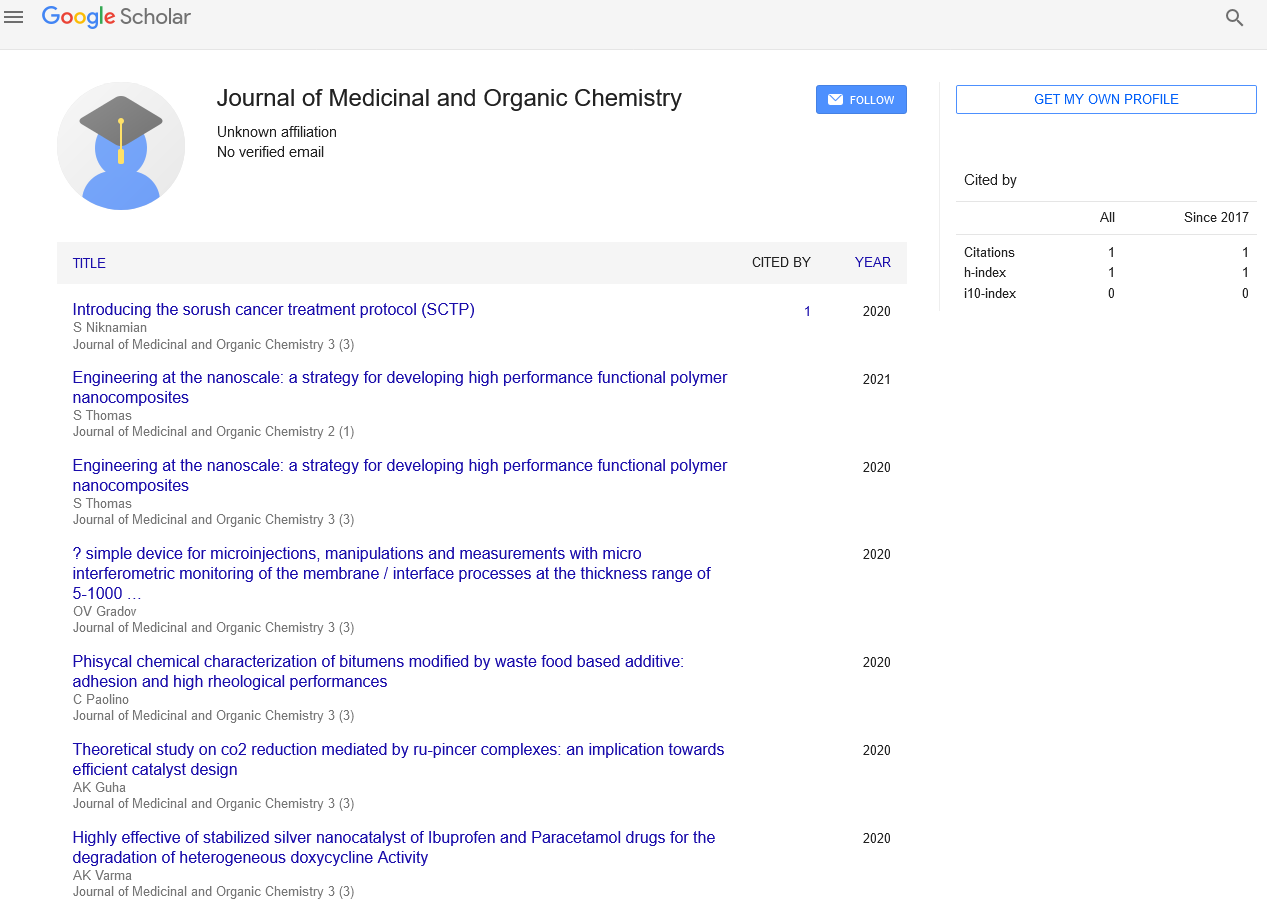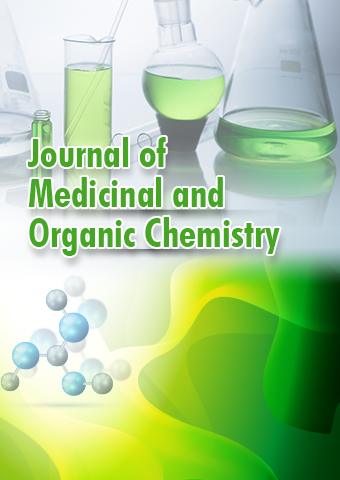Editorial - Journal of Medicinal and Organic Chemistry (2023) Volume 6, Issue 3
Fragment-based Drug Design (FBDD)
Dr. Alika Farhan*
Department of Mediational Chemistry, Drug Design, College of Science, University of Prince Saud, Saudi Arabia
Department of Mediational Chemistry, Drug Design, College of Science, University of Prince Saud, Saudi Arabia
E-mail: alika.f@gmail.com
Received: 02-June-2023, Manuscript No. jmoc-23-101942; Editor assigned: 05-June-2023, PreQC No jmoc-23- 101942; Reviewed: 19-June-2023, QC No. jmoc-23-101942; Revised: 23- June-2023, Manuscript No. jmoc-23- 101942 (R); Published: 30-June-2023; DOI: 10.37532/jmoc.2023.6(3).58-60
Abstract
Fragment-based drug design (FBDD) is a powerful approach used in drug discovery and development to identify and optimize small, fragment-sized molecules into potent and selective drug candidates. It has gained significant attention and popularity in the pharmaceutical industry due to its ability to overcome some of the challenges associated with traditional high-throughput screening (HTS) methods. In traditional HTS, large libraries of diverse compounds are screened against a biological target to identify hits that bind and modulate the target’s activity. While HTS has been successful in identifying lead compounds, it often faces limitations such as compound promiscuity, poor selectivity, and the need for extensive synthetic modifications to optimize the hits into drug candidates. Fragment-based drug design, on the other hand, offers a more rational and efficient approach to lead discovery and optimization. Fragment-based drug design (FBDD) is a powerful strategy used in the development of new pharmaceutical compounds. This approach involves the identification and optimization of small, low molecular weight fragments that bind to a specific target protein or receptor, followed by their assembly into larger compounds with improved potency and selectivity. FBDD offers several advantages over traditional drug discovery methods, including the ability to explore a larger chemical space, the potential for rapid lead discovery, and the ability to target protein-protein interactions. In this review, we discuss the principles and techniques of FBDD, highlight its successful applications in drug discovery, and provide an overview of the challenges and future prospects of this approach.
Keywords
Fragment-based drug design • FBDD • Fragment screening • Fragment optimization • lead discovery • Target protein • receptor • Chemical space • Potency • Selectivity • Protein-protein interactions • Drug discovery • Pharmaceutical compounds
Introduction
In the field of pharmaceutical research and drug development, the process of identifying and designing novel drugs is a complex and time-consuming task. The traditional approach of high-throughput screening (HTS), which involves testing a large library of compounds against a specific target, has limitations in terms of efficiency and success rates [1]. As a result, scientists have turned to innovative strategies to improve the drug discovery process, and one such approach that has gained significant attention is fragment-based drug design (FBDD). Fragment-based drug design represents a paradigm shift in the early stages of drug discovery by focusing on smaller, low-molecular-weight compounds, known as fragments, as starting points for drug development [2]. Unlike traditional approaches that rely on screening large, diverse compound libraries, FBDD focuses on identifying small fragments that can bind to a target protein with high affinity. These fragments serve as the building blocks for developing potent and selective drugs. The basic principle of FBDD involves the screening of small, low molecular weight compounds called fragments. Fragments are typically smaller than 300 Daltons and represent smaller chemical substructures compared to the larger, complex compounds screened in HTS. These fragments are chosen to have a higher degree of chemical diversity, enabling them to explore a larger chemical space and interact with multiple regions of the target protein [3]. Fragment libraries can be generated through various methods, including fragmentbased combinatorial chemistry, virtual screening, or the fragmentation of existing druglike compounds [4]. Once a diverse library of fragments is assembled, they are screened using sensitive biophysical techniques such as nuclear magnetic resonance (NMR) spectroscopy, X-ray crystallography, surface plasmon resonance (SPR), or thermal shift assays (TSA) to identify binding interactions between fragments and the target protein. +The primary advantage of using fragments is their reduced molecular complexity, which allows for a more detailed exploration of the binding site and a better understanding of the structure-activity relationships (SAR). Fragments are designed to interact with specific protein pockets or binding sites, often achieving weak binding affinities [5]. These weak binding affinities are then optimized through iterative cycles of fragment linking, growing, merging, or scaffold hopping to generate more potent compounds. Fragment linking involves combining two or more fragments that bind adjacent sites on the target protein, resulting in a larger molecule with increased binding affinity. Fragment growing, on the other hand, involves adding functional groups or substituents to a fragment to improve its potency and selectivity [6]. Fragment merging combines two or more fragments that bind distinct sites on the target protein, aiming to create a single molecule with improved binding affinity and selectivity. Scaffold hopping involves replacing the fragment’s core scaffold with a different chemical scaffold while retaining the binding interactions. After optimization, the fragments are progressed into hit-to-lead and lead optimization stages, where they are further developed into drug candidates with improved potency, selectivity, pharmacokinetic properties, and drug-like characteristics. This process often involves additional medicinal chemistry techniques, computational modeling, and structure-based design to guide compound optimization and lead to the identification of a clinical candidate. One of the major strengths of FBDD is its ability to explore a vast chemical space efficiently [7]. The use of fragments allows for a focused exploration of the target protein’s binding site, providing valuable information about critical binding interactions and pharmacophores. By identifying key interactions, FBDD can guide the design of compounds with improved potency and selectivity while minimizing off-target effects. Another advantage of FBDD is its potential to target proteinprotein interactions (PPIs) and challenging drug targets [8]. PPIs play crucial roles in various diseases, but they have historically been challenging to target with small molecules due to their large and flat binding surfaces. Fragment-based approaches can overcome these challenges by identifying small fragments that bind to specific regions of the protein-protein interface and then optimizing them into larger molecules that disrupt the interaction [9].
Moreover, fragment-based drug design offers an efficient and cost-effective approach to lead discovery and optimization. Since fragments are smaller and less complex than conventional lead compounds, their synthesis and screening can be carried out at a much faster pace. Additionally, the focused nature of fragment-based approaches reduces the number of compounds that need to be synthesized and tested, thereby saving time, resources, and reducing the attrition rates commonly associated with traditional drug discovery approaches [10].
Conclusion
Fragment-based drug design (FBDD) has emerged as a powerful approach in the field of drug discovery. By focusing on small molecular fragments as starting points, FBDD allows for the efficient exploration of chemical space and the identification of potent and selective drug candidates. FBDD begins with the screening of fragment libraries, which are collections of small, low molecular weight compounds. These fragments bind to the target protein or receptor with low affinity, but their interactions can be detected using biophysical techniques such as X-ray crystallography, NMR spectroscopy, or surface plasmon resonance. This structural information guides the optimization process, where the fragments are chemically elaborated and linked together to increase their binding affinity and selectivity. One of the major advantages of FBDD is its ability to efficiently cover a wide range of chemical space. By exploring small fragments, FBDD can probe diverse interactions and binding modes, allowing for the discovery of novel chemical scaffolds and avoiding the limitations of traditional drug design strategies that rely on larger, more complex molecules.
However, it is important to acknowledge the challenges associated with FBDD. Fragment screening and optimization require expertise in structural biology, biophysical techniques, and medicinal chemistry. The interpretation of fragment binding data can be complex, and the process of fragment linking and optimization requires careful consideration of molecular properties and design principles.
Fragment-based drug design represents a valuable strategy for the discovery and development of new therapeutic agents. Its ability to efficiently explore chemical space, streamline hit-to-lead optimization, and deliver promising drug candidates makes it a valuable tool in the pharmaceutical industry. Continued advancements in FBDD methodologies and technologies are expected to further enhance its impact on drug discovery, leading to the development of innovative and effective treatments for various diseases.
References
- Rezazadeh A, Rashidkhani B, Omidvar N. Association of major dietary patterns with socioeconomic and lifestyle factors of adult women living in Tehran, Iran. Nutrition. 26,337-341 (2010).
- Hung HC, Joshipura KJ, Jiang R et al. Fruit and vegetable intake and risk of major chronic disease. J Natl Cancer Inst. 96,1577-1584 (2004).
- Lutsey PL, Steffen LM, Stevens J. Dietary intake and the development of the metabolic syndrome: the atherosclerosis risk in communities study. Circulation.117,754-761 (2008).
- Slavkin, Harold C. Evolution of the scientific basis for dentistry and its impact on dental education, past, present, and future. Journal of Dental Education. 76, 28-35(2012).
- Leggat PA. Occupational hygiene practices of dentists in southern Thailand. International Dental Journal. 51, 11-16(2001).
- Angum, Fariha, Khan. The Prevalence of Autoimmune Disorders in Women, A Narrative Review. Cureus. 12, 80-94 (2020).
- Delaunois L. Anatomy and physiology of collateral respiratory pathways. The European Respiratory Journal. 2, 893-904 (1989).
- Meldrum OW, Chotirmall SH. Mucus, Microbiomes and Pulmonary Disease. Biomedicines. 9, 675 (2021).
- Lennon MA. One in a million: the first community trial of water fluoridation. Bulletin of the World Health Organization. 84, 759-760(2006).
- Leggat PA. Occupational Health Problems in Modern Dentistry: A Review. Industrial Health. 45, 611-621 (2007).
Indexed at, Google Scholar, Crossref
Indexed at, Google Scholar, Crossref
Indexed at, Google Scholar, Crossref
Indexed at, Google Scholar, Crossref
Indexed at, Google Scholar, Crossref
Indexed at, Google Scholar, Crossref
Indexed at, Google Scholar, Crossref
Indexed at, Google Scholar, Crossref
Indexed at, Google Scholar, Crossref

